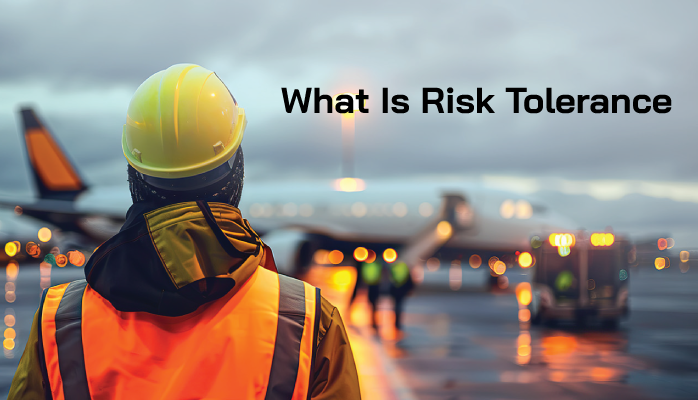Definition of Risk Tolerance

Risk tolerance is simply how much risk you are willing to accept. High-risk tolerance is generally not a good idea because it means that you are willing to “tolerate” or “accept” a high degree of risk for performing tasks. Low-risk tolerance is generally good because it means you err on the side of safety; if it’s risky, don’t do it.
Risk tolerance is something that happens on an organizational level, and an individual level:
- Organizational: how much risk is your organization willing to accept for any safety concern without performing mitigating actions; and
- Individual: how much risk is each employee willing to accept when performing any given task?
On an individual level, an employee may or may not be aware that they are tolerating a high degree of risk. Situational awareness is how employees stay mindful of how risky their actions are.
On an organizational level, aviation service providers should be aware (and document it!) of their stance on risk tolerance. Unfortunately, many aviation safety management systems simply have not taken the time or invested the resources needed to document their safety posture.
Your organization’s safety posture is defined by:
- Your documentation for acceptable/unacceptable safety behavior;
- Mandatory/voluntary reporting policy;
- Your criteria for severity/likelihood; and
- Your documented acceptable level of safety (ALoS).
Having a strong safety posture means clearly understanding and documenting the relationship between certain actions/risks, and how your organization does/doesn’t respond.
Positively vs Negatively Affecting Risk Tolerance

On an individual level, risk tolerance can be negatively affected and positively affected:
- Negatively affecting risk tolerance means that your tolerance for risk increased (BAD!);
- Positively affecting risk tolerance means your tolerance for risk decreases (GOOD!).
Another way of describing this is:
- Negative risk tolerance affect = more risk acceptance;
- Positive risk tolerance affect = less risk acceptance.
As discussed, situational awareness positively affects risk tolerance because employees maintain a low acceptance of risk. The result? If it seems risky, they don’t continue their task.
The goal is to perform tasks with the minimum amount of risk that is reasonable.
Risk Tolerance vs Acceptable Level of Safety
On an organizational level, you define risk tolerance through risk assessments. Simply put:
- You have a risk matrix used for risk assessments;
- Some safety risk assessments require addition actions to mitigate the problem;
- Some assessments do not require additional actions; and
- You define which risk assessments do/don’t require more actions in your SMS manual – i.e., what is and isn’t an acceptable level of safety.
How you define this is your level of risk tolerance.
Risk Factors That Negatively Affect Risk Tolerance
For employees, certain factors negatively affect risk by making employees accept a higher degree of risk (i.e., riskier behavior). These are specific factors that should be addressed in situational awareness training.
They include:
- Familiarity with the task – the more familiar you are, the more complacent you tend to be;
- Time into performing a task – the longer you do something, the more you tend to accept risk in order to complete the task (i.e., continuation bias);
- Overestimating one’s capabilities for performing tasks;
- Social factors – existing norms can strongly affect risk tolerance for the worse if safety culture is bad;
- Too much confidence in technology; and
- Too much confidence in control measures.
It’s important that technology and control measures aside, employees feel responsible for outcomes.
Related Aviation Risk Factors Articles
- Top Factors That Influence Risk Tolerance
- The 13th Aviation SMS Human Factor — Adopting Risk Attitude
- What Are Important Factors of Aviation Risk Management Process
How to Positively Affect Risk Tolerance
Having good risk tolerance may be something that comes naturally, but there are also ways your organization can positively affect it:
- Experience with negative outcomes naturally teaches employees to have a low tolerance
- Hire employees with experience who are willing to admit past mistakes
- New employees tend to be cautious and have a low tolerance
- Reinforce this with clear guidelines, procedures, and checklists
- Strongly stress situational awareness in promotional and training activities
- Ensure that employees are commended for taking the “safe option” during a task, such as stopping to ensure that things are safe.
Last updated February 2025.






